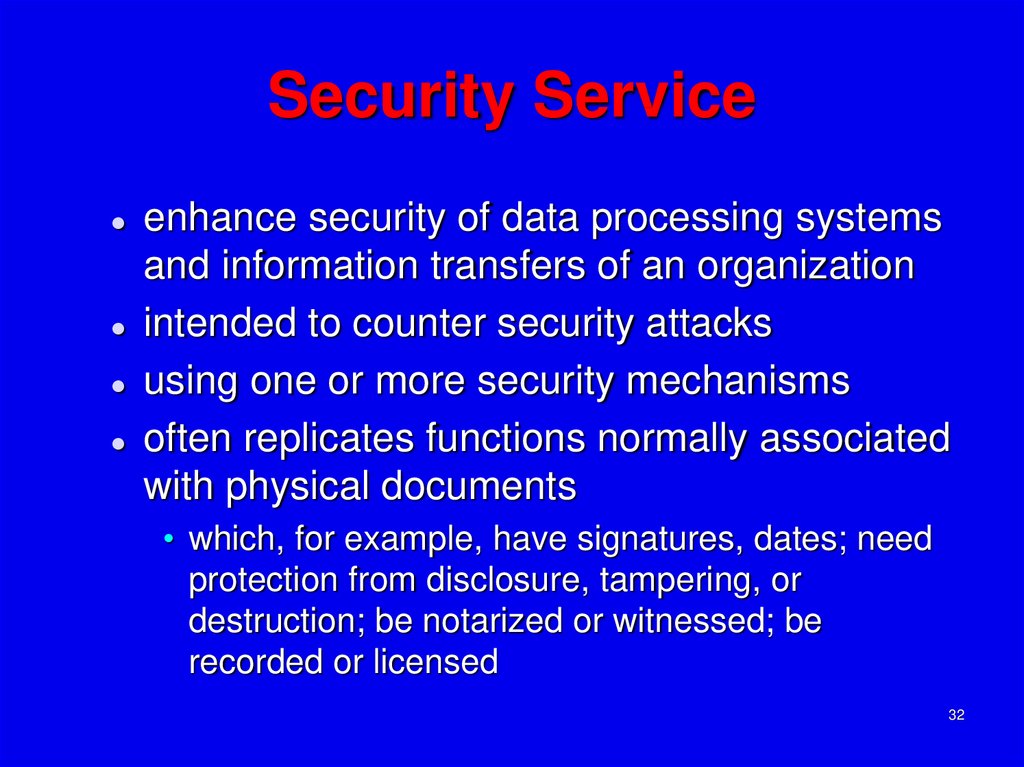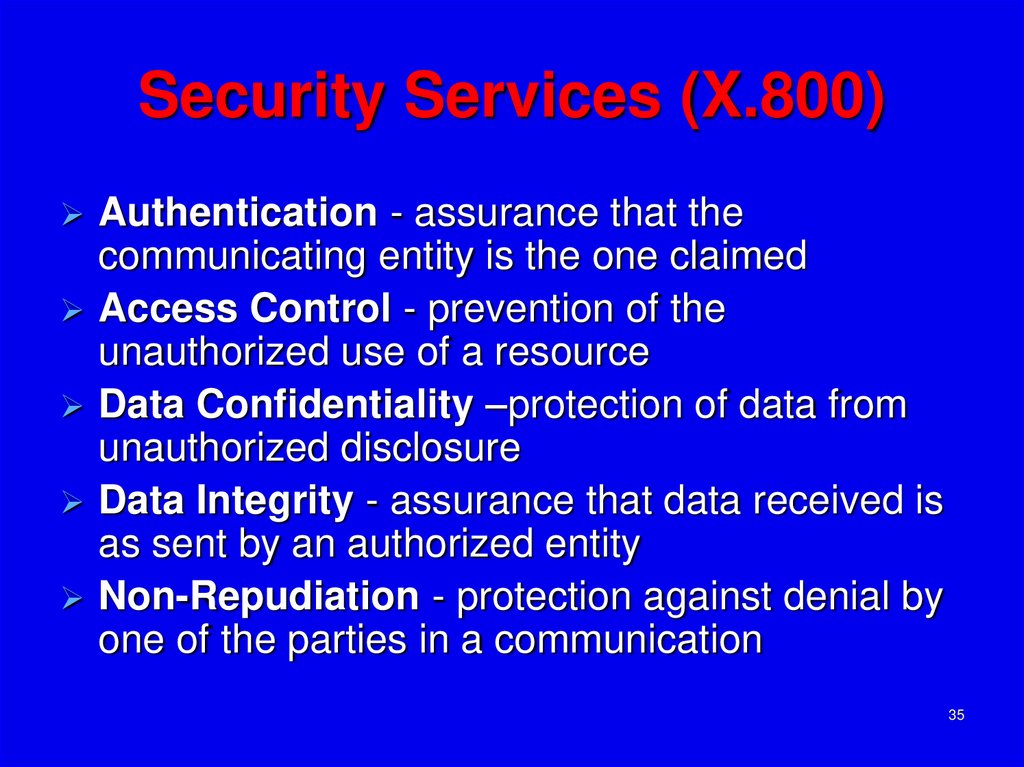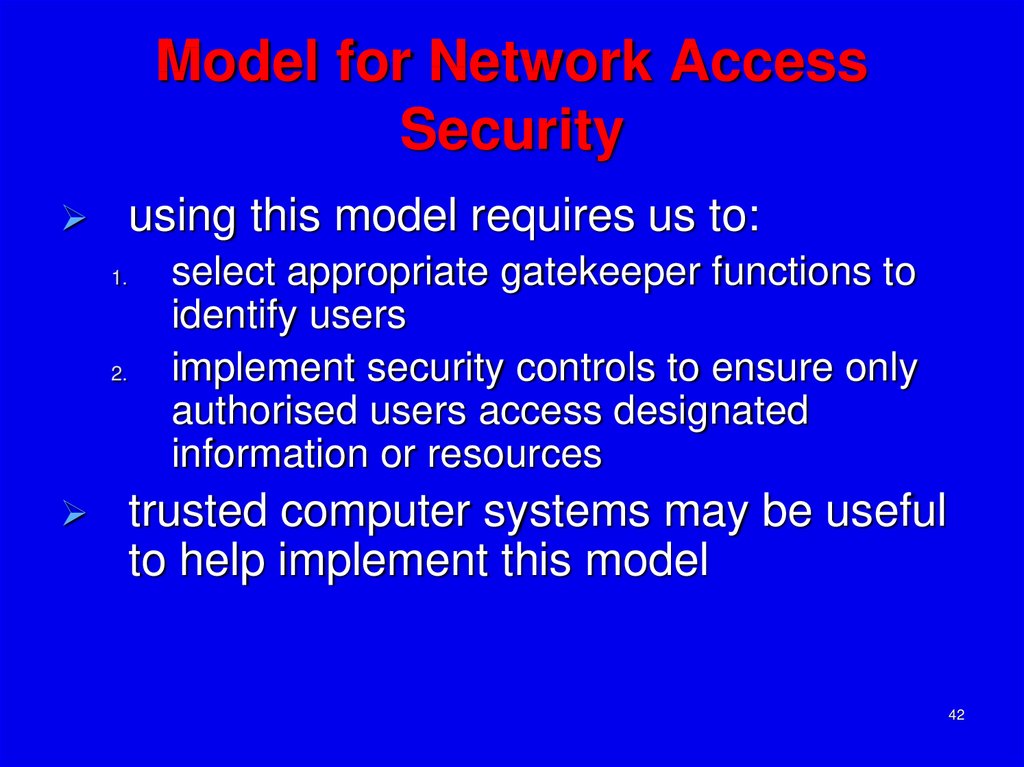Similar presentations:
Network security
1.
Network SecurityDr.Eng.Bader Ahmad
1
2. REFERENCE
Cryptography andNetwork Security
Fifth Edition
by William Stallings
2
3. This course covers the following topics :
IntroductionNetworks
vulnerabilities and attack
Web security
Wireless network security
I P security
Network intrusion detection
3
4. Aim of Course
ourfocus is on Network Security
which consists of measures to deter,
prevent, detect, and correct security
violations that involve the transmission &
storage of information
4
5. Standards Organizations
NationalInstitute of Standards &
Technology (NIST)
Internet Society (ISOC)
International Telecommunication Union
Telecommunication Standardization
Sector (ITU-T)
International Organization for
Standardization (ISO)
5
6. Background
Information Security requirements have changedin recent times
traditionally provided by physical and
administrative mechanisms
computer use requires automated tools to
protect files and other stored information
use of networks and communications links
requires measures to protect data during
transmission
6
7. Computer Security
theprotection afforded to an automated
information system in order to attain the
applicable objectives of preserving the
integrity, availability and confidentiality of
information system resources (includes
hardware, software, information/data, and
telecommunications .
7
8. Key Security Concepts
(Figure 1.1).8
9. Key Security Concepts
Thesethree concepts form what is often
referred to as the CIA triad (Figure 1.1).
The three concepts embody the
fundamental security objectives for both
data and for information and computing
services. FIPS PUB 199 provides a useful
characterization of these three objectives
in terms of requirements and the definition
of a loss of security in each category:
9
10. Key Security Concepts
Confidentiality(covers both data
confidentiality and privacy): preserving
authorized restrictions on information
access and disclosure, including means
for protecting personal privacy and
proprietary information. A loss of
confidentiality is the unauthorized
disclosure of information.
10
11. Key Security Concepts
Integrity (covers both data and system
integrity): Guarding against modification or
destruction of information, and includes
ensuring information non-repudiation and
authenticity. A loss of integrity is the
unauthorized modification or destruction of
information.
11
12. Key Security Concepts
Availability: Ensuring timely and reliable
access to and use of information. A loss of
availability is the disruption of access to or
use of information or an information
system.
12
13. Key Security Concepts
Althoughthe use of the CIA triad to define
security objectives is well established,
some in the security field feel that
additional concepts are needed to present
a complete picture. Two of the most
commonly mentioned are:
13
14. Key Security Concepts
Authenticity: The property of being
genuine and being able to be verified and
trusted; confidence in the validity of a
transmission, a message, or message
originator.
• Accountability: The security goal that
generates the requirement for actions of
an entity to be traced uniquely to that
entity.
14
15. Levels of Impact
candefine 3 levels of impact from a
security breach
Low
Moderate
High
15
16. Levels of Impact
Low: The loss could be expected to have
a limited adverse effect on organizational
operations, organizational assets, or
individuals. A limited adverse effect means
that, for example, the loss of
confidentiality, integrity, or availability
might (i) cause a degradation in mission
capability to an extent and duration that
the organization is able to perform its
primary functions,
16
17. Levels of Impact
butthe effectiveness of the functions is
noticeably reduced; (ii) result in minor
damage to organizational assets; (iii)
result in minor financial loss; or (iv) result
in minor harm to individuals.
17
18. Levels of Impact
Moderate: The loss could be expected to
have a serious adverse effect on
organizational operations, organizational
assets, or individuals. A serious adverse
effect means that, for example, the loss
might (i) cause a significant degradation in
mission capability to an extent and
duration that the organization is able to
perform its primary functions, but the
effectiveness of the functions is significantly reduced;
18
19. Levels of Impact
(ii) result in significant damage toorganizational assets; (iii) result in
significant financial loss; or (iv) result in
significant harm to individuals that does
not involve loss of life or serious, lifethreatening injuries.
19
20. Levels of Impact
High:The loss could be expected to have
a severe or catastrophic adverse effect on
organizational operations, organizational
assets, or individuals. A severe or
catastrophic adverse effect means that, for
example, the loss might (i) cause a severe
degradation in or loss of mission capability
to an extent and duration that the
organization is not able to perform one or
more of its primary functions;
20
21. Levels of Impact
(ii) result in major damage to
organizational assets; (iii) result in major
financial loss; or (iv) result in severe or
catastrophic harm to individuals involving
loss of life or serious life threatening
injuries.
21
22. Definitions
Computer Security - generic name for thecollection of tools designed to protect data and
to thwart hackers
Network Security - measures to protect data
during their transmission
Internet Security - measures to protect data
during their transmission over a collection of
interconnected networks
22
23. Security Trends
2324. OSI Security Architecture
X.800 “Security Architecture for OSI”defines a systematic way of defining and
providing security requirements
for us it provides a useful, if abstract,
overview of concepts we will study
ITU-T
24
25. Aspects of Security
considersecurity attack
security mechanism
security service
note
3 aspects of information security:
terms
threat – a potential for violation of security
attack – an assault on system security, a
deliberate attempt to evade security services
25
26. Security Attack
any action that compromises the security ofinformation owned by an organization
information security is about how to prevent
attacks, or failing that, to detect attacks on
information-based systems
often threat & attack used to mean same thing
have a wide range of attacks
can focus of generic types of attacks
passive
active
26
27. Passive Attacks
2728. Passive Attacks
“passive attacks” which attempt tolearn or make use of information from the
system but does not affect system
resources.
By eavesdropping on, or monitoring of,
transmissions to:
Have
+ obtain message contents or
+ monitor traffic flows
Are
difficult to detect because they do not
involve any alteration of the data.
28
29. Active Attacks
2930. Active Attacks
“activeattacks” which attempt to alter
system resources or affect their operation.
By modification of data stream to:
masquerade of one entity as some other
replay previous messages (as shown
above in Stallings Figure 1.4b)
modify messages in transit
denial of service
30
31. Active Attacks
Activeattacks present the opposite
characteristics of passive attacks.
Whereas passive attacks are difficult to
detect, measures are available to prevent
their success. On the other hand, it is quite
difficult to prevent active attacks
absolutely, because of the wide variety of
potential physical,software,and network
vulnerabilities. Instead, the goal is to
detect active attacks and to recover from
any disruption or delays caused by them.
31
32. Security Service
enhance security of data processing systemsand information transfers of an organization
intended to counter security attacks
using one or more security mechanisms
often replicates functions normally associated
with physical documents
• which, for example, have signatures, dates; need
protection from disclosure, tampering, or
destruction; be notarized or witnessed; be
recorded or licensed
32
33. Security Mechanism
featuredesigned to detect, prevent, or
recover from a security attack
no single mechanism that will support all
services required
however one particular element underlies
many of the security mechanisms in use:
cryptographic techniques
hence
our focus on this topic
33
34. Security Services
X.800:“a service provided by a protocol layer of
communicating open systems, which ensures
adequate security of the systems or of data
transfers”
RFC
2828:
“a processing or communication service
provided by a system to give a specific kind of
protection to system resources”
34
35. Security Services (X.800)
Authentication - assurance that thecommunicating entity is the one claimed
Access Control - prevention of the
unauthorized use of a resource
Data Confidentiality –protection of data from
unauthorized disclosure
Data Integrity - assurance that data received is
as sent by an authorized entity
Non-Repudiation - protection against denial by
one of the parties in a communication
35
36. Security Mechanisms (X.800)
specific security mechanisms:encipherment, digital signatures, access
controls, data integrity, authentication
exchange, traffic padding, routing control,
notarization
pervasive security mechanisms:
trusted functionality, security labels, event
detection, security audit trails, security
recovery
36
37. Model for Network Security
3738. Model for Network Security
Inconsidering the place of encryption, its
useful to use the following two models
The first, illustrated in Figure 1.5, models
information flowing over an insecure
communications channel, in the presence
of possible opponents. Hence an
appropriate security transform
(encryption algorithm) can be used, with
suitable keys, possibly negotiated using
the presence of a trusted third party.
38
39. Model for Network Security
using this model requires to:(there are four basic tasks indesigning a particular security service)
1.
2.
3.
4.
design a suitable algorithm for the security
transformation
generate the secret information (keys) used
by the algorithm
develop methods to distribute and share the
secret information
specify a protocol enabling the principals to
use the transformation and secret
information for a security service
39
40. Model for Network Security
Thesecond, illustrated in Figure 1.6,
model is concerned with controlled access
to information or resources on a computer
system, in the presence of possible
opponents. Here appropriate controls are
needed on the access and within the
system, to provide suitable security. Some
cryptographic techniques are useful here
also.
40
41. Model for Network Access Security
4142. Model for Network Access Security
using this model requires us to:1.
2.
select appropriate gatekeeper functions to
identify users
implement security controls to ensure only
authorised users access designated
information or resources
trusted computer systems may be useful
to help implement this model
42
43. Summary
haveconsidered:
definitions for:
• computer, network, internet security
standards organizations
security concepts:
confidentiality, integrity, availability
X.800
security architecture
security attacks, services, mechanisms
models for network (access) security
43











































 internet
internet








